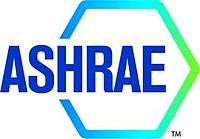ASHRAE

The American Society of Heating, Refrigerating and Air-Conditioning Engineers (doing business since 2012 as ASHRAE[1] /ˈæʃreɪ/ ASH-ray) is a global professional association seeking to advance heating, ventilation, air conditioning and refrigeration (HVAC&R) systems design and construction. Founded in 1894 it now has more than 50,000 members worldwide, composed of building services engineers, architects, mechanical contractors, building owners, equipment manufacturers' employees, and others concerned with the design and construction of HVAC&R systems in buildings. The society funds research projects, offers continuing education programs, and develops and publishes technical standards to improve building services engineering, energy efficiency, indoor air quality, and sustainable development.
History
ASHRAE was founded in 1894 at a meeting of engineers in New York City, formerly headquartered at 345 East 47th Street, and has held an annual meeting since 1895.[2] Until 1954 it was known as the American Society of Heating and Ventilating Engineers (ASHVE); in that year it changed its name to the American Society of Heating and Air-Conditioning Engineers (ASHAE).[3] Its current name and organization came from the 1959 merger of ASHAE and the American Society of Refrigerating Engineers (ASRE).
Despite having 'American' in its name, ASHRAE is a global organization,[4] holding international events.[5][6] In 2012, it rebranded itself with a new logo and tagline: "Shaping Tomorrow's Built Environment Today". As of 2015, ASHRAE has more than 50,000 members.[7][8]
Publications
The ASHRAE Handbook is a four-volume resource for HVAC&R technology and is available in both print and electronic versions. The volumes are Fundamentals, HVAC Applications, HVAC Systems and Equipment, and Refrigeration. One of the four volumes is updated each year.
ASHRAE also publishes a set of standards and guidelines relating to HVAC systems and issues, that are often referenced in building codes and used by consulting engineers, mechanical contractors, architects, and government agencies.[9][10] These standards are periodically reviewed, revised and republished.
Examples of some ASHRAE Standards are:
- Standard 34 – Designation and Safety Classification of Refrigerants
- Standard 55 – Thermal Environmental Conditions for Human Occupancy
- Standard 62.1 – Ventilation for Acceptable Indoor Air Quality (versions: 2001 and earlier as "62", 2004 and beyond as "62.1")
- Standard 62.2 – Ventilation and Acceptable Indoor Air Quality in Low-Rise Residential Buildings
- Standard 90.1 – Energy Standard for Buildings Except Low-Rise Residential Buildings – The IESNA is a joint sponsor of this standard.
- Standard 135 – BACnet - A Data Communication Protocol for Building Automation and Control Networks
- Standard 189.1 – Standard for the Design of High Performance, Green Buildings Except Low-Rise Residential Buildings[11]
The society also publishes two magazines: the ASHRAE Journal is issued monthly, and High Performing Buildings Magazine is published quarterly. They contain articles on related technology, information on upcoming meetings, editorials, and case studies of various well-performing buildings.[12]
ASHRAE also publishes books, ASHRAE Transactions, and the International Journal of HVAC&R Research.
Legislation
ASHRAE supported the Streamlining Energy Efficiency for Schools Act of 2014 (H.R. 4092; 113th Congress), a bill that would require the United States Department of Energy to establish a centralized clearinghouse to disseminate information on federal programs, incentives, and mechanisms for financing energy-efficient retrofits and upgrades at schools.[13][14]
Headquarters renewal
To demonstrate the Society's commitment to sustainability, ASHRAE renovated its existing headquarters building in Atlanta, Ga. After the renovation and occupancy in June 2008, the building has received many awards, including an Energy Star rating with a score of 95 and Platinum Certification from USGBC's LEED program. The current site energy use intensity (EUI) is 35.8 kBtu/Sqft (411 MJ/m2), a 60 percent reduction from the pre-renovation value. The renovation included the use of a dedicated outdoor air supply (DOAS) system with energy recovery and humidity control; a ground-source heat pump system (GSHP); and variable refrigerant flow systems with heat recovery.[15]
The building also serves as a live case study. A web-based user interface allows researchers around the world to extract data from the building to study factors such as energy use and electric power demand, water consumption and indoor air quality.[16]
See also
References
- ↑ "About ASHRAE". Retrieved 2018-06-18.
- ↑ "PURE AIR FOR TENEMENTS; THE SUGGESTIONS OF E.P. BATES TO FELLOW ENGINEERS". The New York Times. 23 January 1895. Retrieved 2009-08-15.
- ↑ "Trade Group Changes Name". The New York Times (subscription required). 26 November 1954. Retrieved 2009-08-15.
- ↑ Wong, Albert (18 August 2006). "Bus air-con gives medics the chills". The Standard, Hong Kong. Archived from the original on 4 June 2011. Retrieved 2009-08-15.
- ↑ Pradesh, Andhra (6 May 2007). "Workshop on 'Green Buildings'". The Hindu, India. Retrieved 2009-08-15.
- ↑ "Heating industry aims zero ozone depletion". The Hindu Business Line, India. 14 February 2008. Retrieved 2009-08-15.
- ↑ Miller, Mark. "Overview of ASHRAE". And Services. Retrieved 14 October 2015.
- ↑ "ASHRAE Rebranding Itself to Reflect Expanding Role". 10 February 2012.
- ↑ "Energy efficiency traps moisture". The Free Lance–Star, Indiana, USA. 22 September 1983. Retrieved 2009-08-15.
- ↑ Charles, Eleonor (12 August 1990). "In the Region: Connecticut and Westchester; The Problem of 'Sick Building Syndrome'". The New York Times. Retrieved 2009-08-15.
- ↑ "ASHRAE Standard 189.1 Published". Contracting Business News. 24 January 2010. Retrieved 2010-11-29.
- ↑ "High Performing Buildings". www.hpbmagazine.org.
- ↑ "CBO - H.R. 4092". Congressional Budget Office. Retrieved 22 June 2014.
- ↑ "House Committee Unanimously Approves Energy Efficiency for Schools Act". SBC Magazine. 5 May 2014. Retrieved 23 June 2014.
- ↑ "ASHRAE Headquarters Renovation | U.S. Green Building Council". www.usgbc.org. Retrieved 2018-10-08.
- ↑ "ashrae.org".
External links
- ASHRAE Web site
- ASHRAE publications
- The AHR Expo - Co-Sponsored by ASHRAE and ARI
- ASHRAE Terminology
- ASHRAE Building Energy Quotient Program